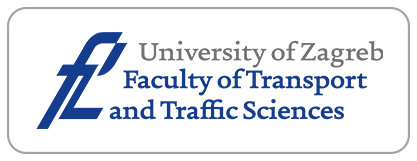Choice of Lane-Changing Point in an Urban Intertunnel Weaving Section Based on Random Forest and Support Vector Machine
Downloads
Urban intertunnel weaving (UIW) section is a special type of weaving section, where various lane-changing behaviours occur. To gain insight into the lane-changing behaviour in the UIW section, in this paper we attempt to analyse the decision feature and model the behaviour from the lane-changing point selection perspective. Based on field-collected lane-changing trajectory data, the lane-changing behaviours are divided into four types. Random forest method is applied to analyse the influencing factors of choice of lane-changing point. Moreover, a support vector machine model is adopted to perform decision behaviour modelling. Results reveal that there are significant differences in the influencing factors for different lane-changing types and different positions in the UIW segment. The three most important factor types are object vehicle status, current-lane rear vehicle status and target-lane rear vehicle status. The precision of the choice of lane-changing point models is at least 82%. The proposed method could reveal the detailed features of the lane-changing point selection behaviour in the UIW section and also provide a feasible choice of lane-changing point model.
Downloads
Ali Y, et al. The impact of the connected environment on driving behaviour and safety: A driving simulator study. Accident Analysis and Prevention. 2020;144. DOI: 10.1016/j.aap.2020.105643.
Zhu J, Tasic I, Qu X. Flow-level coordination of connected and autonomous vehicles in multilane freeway ramp merging areas. Multimodal Transportation. 2022;1(1). DOI: 10.1016/j.multra.2022.100005.
Ouyang P, et al. Traffic safety analysis of inter-tunnel weaving section with conflict prediction models. Journal of Transportation Safety & Security. 2022;14(4):630-654. DOI: 10.1080/19439962.2020.1801924.
Peng B, et al. Multi-stage lane changing decision model of urban trunk road’s short weaving area based on Cellular Automata. Journal of Transportation Systems Engineering and Information Technology. 2020;20(04):41-48+70. DOI: 10.16097/j.cnki.1009-6744.2020.04.007.
Duan K, et al. Analysis of driver’s decision distance and merging distance in work zone area based on parametric survival models: With the aid of a driving simulator experiment. Transportation Research Part F - Traffic Psychology and Behaviour. 2020;71:31-48. DOI: 10.1016/j.trf.2020.03.017.
Moridpour S, et al. Lane-changing decision model for heavy vehicle drivers. Journal of Intelligent Transportation Systems. 2012;16(1):24-35. DOI: 10.1080/15472450.2012.639640.
Jin H, et al. Gauss mixture hidden Markov model to characterise and model discretionary lane-change behaviours for autonomous vehicles. IET Intelligent Transport Systems. 2020;14(5):401-411. DOI: 10.1049/iet-its.2019.0446.
Li L, et al. Retrieving common discretionary lane changing characteristics from trajectories. IEEE Transactions on Vehicular Technology. 2018;67(3):2014-2024. DOI: 10.1109/TVT.2017.2771144.
Van Beinum A, et al. Driving behaviour at motorway ramps and weaving segments based on empirical trajectory data. Transportation Research Part C - Emerging Technologies. 2018;92:426-441. DOI: 10.1016/j.trc.2018.05.018.
Das A, Khan MN, Ahmed MM. Detecting lane change maneuvers using SHRP2 naturalistic driving data: A comparative study machine learning techniques. Accident Analysis and Prevention. 2020;142. DOI: 10.1016/j.aap.2020.105578.
Balal E, Cheu RL. Comparative evaluation of fuzzy inference system, support vector machine and multilayer feed-forward neural network in making discretionary lane changing decisions. Neural Network World. 2018;28(4):361-378. DOI: 10.14311/NNW.2018.28.021.
Feng H, Deng J, Ge T. Multi-attributes lane-changing decision model based on entropy weight with driving styles. Journal of Transportation Systems Engineering and Information Technology. 2020;20(02):139-144. DOI: 10.16097/j.cnki.1009-6744.2020.02.021.
Huo D, Ma J, Chang R. Lane-changing-decision characteristics and the allocation of visual attention of drivers with an angry driving style. Transportation Research Part F - Traffic Psychology and Behaviour. 2020;71:62-75. DOI: 10.1016/j.trf.2020.03.008.
Hang J, et al. Exploring the effects of the location of the lane-end sign and traffic volume on multistage lanechanging behaviours in work zone areas: A driving simulator-based study. Transportation Research Part F - Traffic Psychology and Behaviour. 2018;58:980-993. DOI: 10.1016/j.trf.2018.07.024.
Gan X, et al. Spatial-temporal varying coefficient model for lane-changing behaviour in work zone merging areas. Journal of Transportation Safety & Security. 2020;14(6):949-972. DOI: 10.1080/19439962.2020.1864075.
Pan TL, et al. Modeling the impacts of mandatory and discretionary lane-changing maneuvers. Transportation Research Part C - Emerging Technologies. 2016;68:403-424. DOI: 10.1016/j.trc.2016.05.002.
Deng S. et al. A dynamic variety model to describe the traffic flow of target lane affected by lane change on urban road. Advances in Mechanical Engineering. 2019;11(4). DOI: 10.1177/1687814019844066.
Toledo T, Koutsopoulos HN, Ben-Akiva ME. Modeling integrated lane-changing behaviour. Transportation Research Record Journal of the Transportation Research Board. 2003;1857(1): 30-38. DOI: 10.3141/1857-04.
Nilsson P, Laine L, Jacobson B. A simulator study comparing characteristics of manual and automated driving during lane changes of long combination vehicles. IEEE Transactions on Intelligent Transportation Systems. 2017;18(9):2514-2524. DOI: 10.1109/TITS.2017.2664890.
Ross V, et al. Investigating the influence of working memory capacity when driving behaviour is combined with cognitive load: An LCT study of young novice drivers. Accident Analysis and Prevention. 2014;62:377-387. DOI: 10.1016/j.aap.2013.06.032.
Antin JF, et al. Investigating lane change behaviours and difficulties for senior drivers using naturalistic driving data. Journal of Safety Research. 2020;74:81-87. DOI: 10.1016/j.jsr.2020.04.008.
Peng J, et al. Multi-parameter prediction of drivers’ lane-changing behaviour with neural network model. Applied Ergonomics. 2015;50:207-217. DOI: 10.1016/j.apergo.2015.03.017.
Yang D, et al. A dynamic lane-changing trajectory planning model for automated vehicles. Transportation Research Part C - Emerging Technologies. 2018;95:228-247. DOI: 10.1016/j.trc.2018.06.007.
Wang H, Xu S, Deng L. Automatic lane-changing decision based on single-step dynamic game with incomplete information and collision-free path planning. Actuators. 2021;10(8). DOI: 10.3390/act10080173.
Zheng O. Developing a Traffic Safety Diagnostics System for Unmanned Aerial Vehicles Using Deep Learning Algorithms. PhD thesis. University of Central Florida; 2019.
Zhao Y, et al. Trajectory-based characteristic analysis and decision modeling of the lane-changing process in intertunnel weaving sections. Plos One. 2022;17(4). DOI: 10.1371/journal.pone.0266489.
Deng J, Feng H. A multilane cellular automaton multi-attribute lane-changing decision model. Physica A - Statistical Mechanics and its Applications. 2019;529. DOI: 10.1016/j.physa.2019.121545.
Pang M, et al. A probability lane-changing model considering memory effect and driver heterogeneity. Transportmetrica B - Transport Dynamics. 2020;8(1):72-89. DOI: 10.1080/21680566.2020.1715310.
Copyright (c) 2023 Chuwei Zhao, Yi Zhao, Zhiqi Wang, Jianxiao Ma, Minghao Li

This work is licensed under a Creative Commons Attribution-NonCommercial 4.0 International License.
















